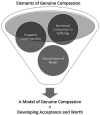Experiences of Compassion in Adults With a Diagnosis of Borderline Personality Disorder: An Interpretative Phenomenological Analysis
- PMID: 33730923
- PMCID: PMC9136373
- DOI: 10.1177/00332941211000661
Experiences of Compassion in Adults With a Diagnosis of Borderline Personality Disorder: An Interpretative Phenomenological Analysis
Abstract
The study explored experiences of compassion in adults with a diagnosis of Borderline Personality Disorder (BPD) to further the development of the construct of compassion in relation to BPD. Interpretative Phenomenological Analysis was used to develop themes from the narratives of six adults with a diagnosis of BPD. Five themes emerged: Emotional Connection to Suffering, Empathic Understanding, Prioritisation of Needs, A Model of Genuine Compassion and Developing Acceptance and Worth. Participants described the role of compassion in their difficulties, including the adverse impact of experiences of incompassion upon their sense of self. The themes were integrated into a model that highlighted a process of recovery through therapeutic encounters with others in which genuine compassion was modelled. In addition, barriers to compassion and factors facilitating the development of compassion emerged from the analysis and have implications for clinical practice.
Keywords: Borderline personality disorder; compassion; interpretative phenomenological analysis; qualitative.
Conflict of interest statement
Figures
Similar articles
-
Exploring Barriers to Compassionate Acts in Individuals with Borderline Personality Disorder: A Critical Literature Review.Personal Ment Health. 2025 May;19(2):e70020. doi: 10.1002/pmh.70020. Personal Ment Health. 2025. PMID: 40242943 Free PMC article. Review.
-
An exploration of people's experiences of compassion-focused therapy for trauma, using interpretative phenomenological analysis.Clin Psychol Psychother. 2014 Nov-Dec;21(6):495-507. doi: 10.1002/cpp.1854. Epub 2013 Jul 24. Clin Psychol Psychother. 2014. PMID: 23893917
-
Borderline personality disorder and childhood trauma: Exploring the buffering role of self-compassion and self-esteem.J Clin Psychol. 2021 Mar;77(3):837-845. doi: 10.1002/jclp.23070. Epub 2020 Oct 10. J Clin Psychol. 2021. PMID: 33037647
-
'I'm ruined': Young people's and their mothers' experiences of living with, and receiving a diagnosis of, borderline personality disorder: An interpretative phenomenological analysis.Psychol Psychother. 2025 Jun;98(2):361-372. doi: 10.1111/papt.12549. Epub 2024 Oct 7. Psychol Psychother. 2025. PMID: 39373270 Free PMC article.
-
Dysfunction of Empathy and Related Processes in Borderline Personality Disorder: A Systematic Review.Harv Rev Psychiatry. 2020 Jul/Aug;28(4):238-254. doi: 10.1097/HRP.0000000000000260. Harv Rev Psychiatry. 2020. PMID: 32692088 Free PMC article.
Cited by
-
Exploring Barriers to Compassionate Acts in Individuals with Borderline Personality Disorder: A Critical Literature Review.Personal Ment Health. 2025 May;19(2):e70020. doi: 10.1002/pmh.70020. Personal Ment Health. 2025. PMID: 40242943 Free PMC article. Review.
References
-
- Aguirre B. (2016). Borderline personality disorder: From stigma to compassionate care. In: Parekh R., Childs E. (Eds.), Stigma and prejudice. Current clinical psychiatry (pp. 133–143). Humana Press. 10.1007/978-3-319-27580-2_8 - DOI
-
- American Psychiatric Association. (2013). Diagnostic and statistical manual of mental disorders, fifth edition (DSM-5).
MeSH terms
LinkOut - more resources
Full Text Sources
Other Literature Sources


